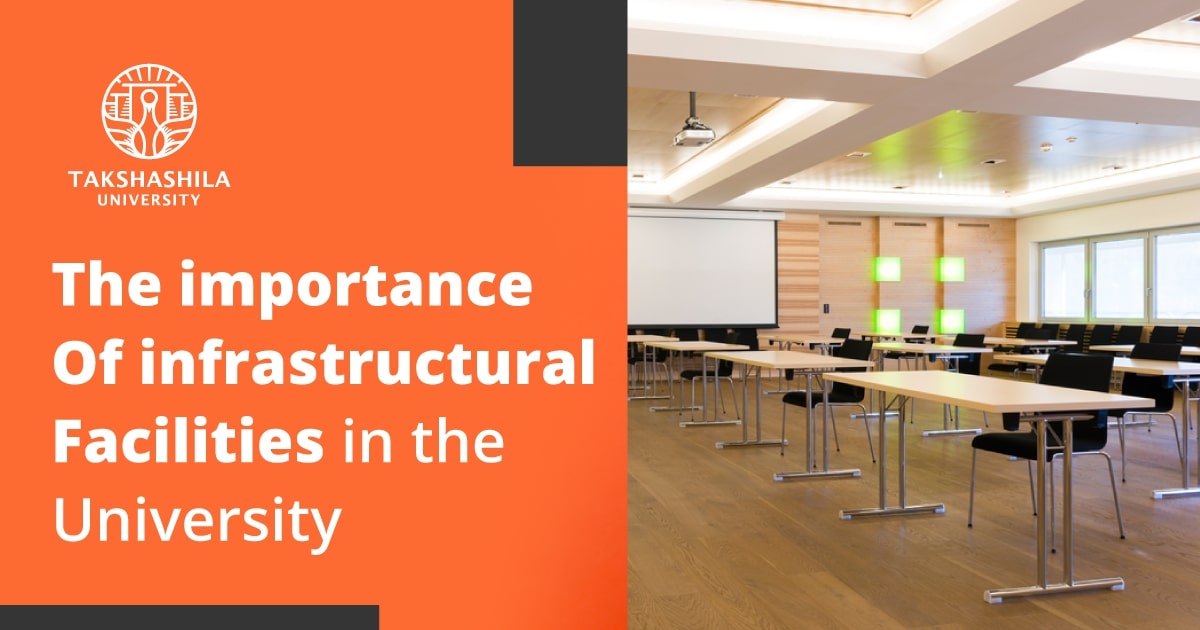Introduction
Imagine stepping into a university that feels more like a thriving ecosystem than a mere educational institution. This is where the magic of infrastructural facilities in the university comes into play.
Takshashila University are not just places where students earn degrees; they are vital hubs of knowledge, innovation, and societal advancement.
The importance of infrastructural facilities in the university cannot be overstated. These facilities are the backbone of a conducive learning environment, fostering the holistic development of students and propelling the institution towards success.
From state-of-the-art libraries to cutting-edge research labs and vibrant student centres, every aspect of infrastructural facilities in the university plays a pivotal role in shaping future leaders.
By investing in and prioritising these facilities, we ensure that universities remain at the forefront of education and innovation, providing students with the resources they need to excel both academically and personally.
Let’s find out why these facilities are indispensable and how they contribute to a thriving academic community.
Takshashila University: A Model of Excellence in Infrastructure
Takshashila University stands as the epitome of excellence, showcasing how infrastructural facilities in the university can drive student success and research excellence. The campus is a testament to forward-thinking design and state-of-the-art facilities that provide a world-class learning environment.
One of the standout infrastructural facilities in the university is the Central Library. Boasting an extensive collection of books, digital resources, and quiet study areas, it’s a haven for students and researchers alike.
The advanced Research Laboratories are equipped with cutting-edge technology, enabling groundbreaking experiments and innovative studies. These labs not only foster academic curiosity but also support students in conducting high-quality research.
The university’s commitment to student well-being is evident in its top-notch residential facilities. Spacious and comfortable hostels provide a home-away-from-home experience, while the modern dining halls offer nutritious meals that cater to diverse dietary needs.
Furthermore, Takshashila University has dedicated spaces for co-curricular activities, including auditoriums and performance halls that host various cultural events and academic conferences. These infrastructural facilities in the university play a crucial role in nurturing talent and fostering a vibrant campus life.
The Impact of Infrastructure on Student Life
Infrastructural facilities in the university have a profound impact on student life, shaping their academic journey and personal growth in myriad ways.
First things first, let’s talk about the learning environment. Infrastructural facilities in the university such as modern classrooms, well-stocked libraries, and advanced laboratories are pivotal. These spaces significantly influence student engagement and academic performance.
A well-designed classroom with the latest technology can make lectures more interactive and engaging. Libraries stocked with diverse resources offer a quiet haven for study and research, while state-of-the-art labs provide hands-on experience crucial for understanding complex concepts.
- Modern classrooms enhance interaction and learning.
- Libraries serve as essential resources for study and research.
- Labs offer practical experience vital for comprehension.
Beyond academics, student well-being is another critical area impacted by infrastructural facilities in the university. Comfortable hostels, hygienic dining halls, and well-maintained sports grounds contribute to the health and happiness of students.
A good hostel environment can make students feel at home, promoting better mental health and social interaction. Dining halls that provide nutritious meals ensure students maintain a balanced diet, while sports facilities encourage physical activity, crucial for overall well-being.
- Hostels create a home-like environment, boosting mental health.
- Dining halls offering nutritious food support a balanced diet.
- Sports grounds promote physical fitness and social interaction.
Lastly, infrastructural facilities in the university play a vital role in supporting co-curricular activities. Clubs, societies, and cultural events thrive on the availability of proper venues and resources.
Auditoriums for performances, rooms for club meetings, and spaces for cultural activities foster a vibrant campus life. These activities not only enhance student skills but also build a sense of community and belonging.
- Auditoriums and performance spaces support cultural events.
- Meeting rooms enable the functioning of clubs and societies.
- Spaces for cultural activities build community spirit.
Infrastructure as a Catalyst for Research and Innovation
Infrastructural facilities in the university are not just about creating a pleasant campus; they are the heartbeat of research and innovation, driving progress and discovery in myriad fields.
Research Facilities
- Modern labs drive groundbreaking experiments and enable complex studies.
- State-of-the-art research centres foster innovation by providing cutting-edge equipment and resources.
- Well-equipped laboratories become incubators for new ideas and advancements.
Technology Infrastructure
- High-speed internet supports seamless research processes and everyday academic activities.
- Robust digital resources like online journals and digital libraries are crucial for comprehensive research.
- Reliable tech backbone ensures data can be shared and accessed globally without hindrance.
Industry Collaborations
- Innovation hubs facilitate university-industry interactions, creating spaces designed for collaboration.
- Collaborative spaces like conference rooms attract industry partnerships and funding opportunities.
- Joint research projects and real-world applications of academic research benefit from these partnerships.
The Economic Impact of University Infrastructure
Infrastructural facilities in the university are more than just buildings and classrooms; they are powerful engines of economic growth, generating a ripple effect that benefits both the university and the wider community.
First, let’s discuss job creation. The development of infrastructural facilities in the university creates numerous employment opportunities. From construction workers to architects, and from project managers to suppliers, the process of building and maintaining university infrastructure engages a vast array of professionals.
This influx of jobs not only supports individuals and families but also stimulates local economies by increasing demand for goods and services.
Moreover, the impact of infrastructural facilities in the university extends to the local economy. Businesses around the university thrive due to increased foot traffic from students, staff, and visitors. Cafes, bookstores, and retail shops benefit from the consistent demand.
Additionally, universities often partner with local businesses for supplies and services, further integrating the institution into the economic fabric of the community.
Finally, let’s talk about the return on investment. Investing in infrastructural facilities in the university demonstrates significant long-term benefits. State-of-the-art facilities attract top-tier faculty and ambitious students, enhancing the institution’s reputation and academic standing.
This, in turn, can lead to increased enrolment, higher tuition revenues, and more substantial research grants. The economic benefits multiply as well-educated graduates enter the workforce, driving innovation and contributing to economic growth.
Conclusion
Infrastructural facilities in the university are vital for fostering an environment that nurtures academic excellence, research innovation, and student well-being. At Takshashila University, these facilities are more than just buildings; they are the foundation of a thriving academic community.
I encourage other universities to take a leaf out of Takshashila University’s book and prioritise infrastructure development. Investing in state-of-the-art libraries, research labs, residential facilities, and sports complexes ensures students and faculty have the resources they need to excel.
By focusing on infrastructural facilities in the university, we can create spaces where knowledge flourishes, innovation thrives, and communities grow stronger. Let’s build a future where every student has access to world-class facilities that inspire and empower.
FAQs
1. Why are infrastructural facilities in the university important?
Infrastructural facilities in the university are crucial as they provide the physical environment necessary for learning, research, and overall student well-being. Modern facilities enhance academic performance and foster innovation. They also create a conducive atmosphere for personal and professional growth.
2. How do infrastructural facilities in the university impact student success?
Infrastructural facilities in the university, such as advanced classrooms, libraries, and labs, directly influence student engagement and academic outcomes. These resources offer students the tools and environments needed for effective study and research. Comfortable living and recreational facilities also support overall well-being.
3. What role do infrastructural facilities in the university play in research excellence?
State-of-the-art research labs and centres are essential infrastructural facilities in the university that enable cutting-edge experiments and studies. These facilities attract top researchers and foster innovative projects. High-quality infrastructure ensures the university remains competitive in global research.
4. How can infrastructural facilities in the university benefit the local community?
Infrastructural facilities in the university can stimulate the local economy by creating jobs and attracting businesses. Universities often partner with local enterprises for services and supplies, boosting economic activity. Additionally, community access to university facilities can enhance local educational and cultural opportunities.
5. What are some examples of essential infrastructural facilities in the university?
Essential infrastructural facilities in the university include modern classrooms, well-equipped libraries, advanced research labs, comfortable dormitories, and sports complexes. These facilities support academic learning, research, student life, and physical health. They create a comprehensive environment conducive to holistic development.






